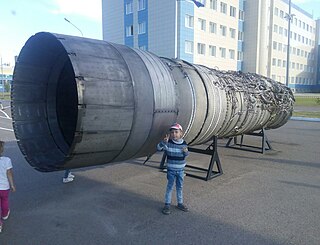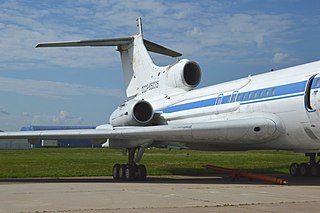Related Research Articles

The Soloviev D-30 is a Soviet two-shaft low-bypass turbofan engine, officially referred to as a "bypass turbojet". It is probably the single most important turbofan engine developed in the Soviet Union. Development of the turbofan spurred numerous growth versions with increased fan diameter and modified component arrangements. Developed within an amazingly short period of time, the D-30 turned out to be one of the most reliable engines in the history of Soviet engine development, and its development was recognized with the USSR State Prize.
The Kuznetsov Design Bureau was a Russian design bureau for aircraft engines, administrated in Soviet times by Nikolai Dmitriyevich Kuznetsov. It was also known as (G)NPO Trud and Kuybyshev Engine Design Bureau (KKBM).
The Tumansky R-15 is an axial flow, single shaft turbojet with an afterburner. Its best known use is on the Mikoyan-Gurevich MiG-25.

The Saturn AL-31 is a family of military turbofan engines, developed by the Lyulka, now NPO Saturn, in the Soviet Union/Russia, originally for the Sukhoi Su-27 air superiority fighter. It produces a thrust of 28,000 lbf (123 kN) with afterburning in the AL-31F, 31,000 lbf (137 kN) in the AL-31FM (AL-35F) and 33,000 lbf (145 kN) in the AL-37FU variants. Currently it powers all Su-27 derivatives and the Chengdu J-10 multirole jet fighter which has been developed under a Russian license by China. The AL-31 is a Heavily Upgraded Version of the Lyulka AL-21

The Tupolev Tu-244 was a proposed supersonic transport (SST) aircraft, developed from the Tu-144. It implemented novel features such as cryogenic fuel to enable flight distances of up to 10,000 km (6,214 mi) and would have carried up to 300 passengers. The project was cancelled in 1993.

The Kuznetsov NK-32 is an afterburning three-spool low bypass turbofan jet engine which powers the Tupolev Tu-160 supersonic bomber, and was fitted to the later model Tupolev Tu-144LL supersonic transport. It produces 245 kN (55,000 lbf) of thrust in afterburner.

The NK-8 was a low-bypass turbofan engine built by the Kuznetsov Design Bureau, in the 90 kN (20,000 lbf) thrust class. It powered production models of the Ilyushin Il-62 and the Tupolev Tu-154A and B models.

The Kuznetsov NK-86 is a low bypass turbofan engine used on the Ilyushin Il-86 rated at 13,000 kgf or 28,600 lbf thrust. It is made by the Soviet Kuznetsov Design Bureau. It is an upgraded version of the Kuznetsov NK-8.

The Kuznetsov NK-144 is an afterburning turbofan engine made by the Soviet Kuznetsov Design Bureau. Used on the early models of the Tupolev Tu-144 supersonic aircraft, it was very inefficient and was replaced with the Kolesov RD-36-51 turbojet engine.
JSC Kuznetsov is one of the leading Russian producers of aircraft engines, liquid-propellant rocket engines as well as aeroderivative gas turbines and modular stations.
The Kuznetsov NK-87 is a low-bypass turbofan engine rated at 127.5 kN thrust. It powers the Lun-class ekranoplan. It is made by the soviet Kuznetsov Design Bureau.

The Kuznetsov NK-25 is a turbofan aircraft engine used in the Tupolev Tu-22M strategic bomber. It can equal the NK-321 engine as one of the most powerful supersonic engines in service today. It is rated at 245 kN (55,000 lbf) thrust. The three shaft engine we call the NK-25 was designed in the years 1972–1974. It is made by the Soviet Kuznetsov Design Bureau.

The Progress D-436 is a three-shaft high by-pass turbofan engine developed by the Ukrainian company Ivchenko-Progress. It was initially developed to meet the requirements for late versions of the Yakovlev Yak-42 and the Antonov An-72 in the 1980s. The engine first ran in 1985 and was subsequently certified in 1987. Several variants have been developed and are currently in service with a variety of aircraft.

The Kuznetsov NK-93 was a civilian aircraft engine, a hybrid between a turbofan and a turboprop known as a propfan. The engine was also unique in having a separate duct around the contra-rotating propellers, as most other propfans are unducted. Once described in a respected aviation encyclopedia as "potentially the most fuel-efficient aircraft jet engine ever to be tested," the NK-93 was targeted for derivatives of Soviet/Russian airliners such as the Ilyushin Il-96, Tupolev Tu-204, and Tupolev Tu-330. Five in-flight engine tests were conducted on the NK-93 from December 2006 to December 2008.
The Kuznetsov NK-4 was a Soviet turboprop engine, designed by the Kuznetsov Design Bureau.
The Kuznetsov NK-22 is an afterburning turbofan engine, designed by the Kuznetsov Design Bureau.

The Kuznetsov NK-88 was an experimental alternative fuel turbofan engine, designed by the Kuznetsov Design Bureau.
The Kuznetsov NK-89 was an experimental alternative fuel turbofan engine, designed by the Kuznetsov Design Bureau.

The Kuznetsov TV-022 was the first Soviet turboprop engine, designed by the Kuybyshev Engine Design Bureau.
The Kuznetsov TV-2 was an early Soviet turboprop engine, designed by the Kuybyshev Engine Design Bureau.
References
- 1 2 3 4 5 6 7 8 9 10 11 12 13 14 15 16 17 18 19 20 Otechestvennaya aviatsionno-kosmicheskaya tekhnika - SAMARSKIY NTK (in Russian). Samara, Russia: SNTK imeni N.D.Kuznetsova. pp. 23, 24, 73.
- 1 2 3 4 "Tot samyy "NK"". engine.aviaport.ru (in Russian). Nikolay Aleksandrov. Retrieved 4 October 2021.
- 1 2 "NK-6". airbase.ru. Retrieved 13 October 2021.
- ↑ "Tupolev Andrei Nikolaevich". www.aviation.ru. Retrieved 13 October 2021.
- 1 2 3 4 "НК-12". ru.wikipedia.org. Retrieved 13 October 2021.